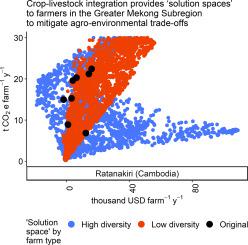Agricultural Systems ( IF 6.1 ) Pub Date : 2021-10-23 , DOI: 10.1016/j.agsy.2021.103285 B.K. Paul 1 , C.A. Epper 1, 2, 3 , D.J. Tschopp 2 , C.T.M. Long 4 , V. Tungani 1 , D. Burra 5, 6 , L. Hok 7 , P. Phengsavanh 8 , S. Douxchamps 6

|
CONTEXT
The Greater Mekong Subregion has been undergoing rapid agricultural transformation over the last decades, as traditional diverse subsistence-oriented agriculture is evolving towards intensified commercial production systems. Negative environmental impacts often include deforestation, nutrient pollution, and greenhouse gas (GHG) emissions.
OBJECTIVE
This study aims to explore the potential of crop-livestock integration to mitigate trade-offs between economic and environmental impacts of smallholder farming systems at different stages of agricultural transition and degrees of agricultural diversity across the Greater Mekong Subregion.
METHODS
We chose a ‘middle ground’ between detailed modeling of few, representative farming systems and modeling of large household populations. 24 low and high diversity farms were selected in Laos (Xieng Khouang province), Cambodia (Ratanakiri province) and Vietnam (Central Highlands) from a survey dataset of 1300 households. These farming systems were simulated with the whole-farm bio-economic and multi-objective optimization model FarmDESIGN, calculating operating profit, GHG emissions and nitrogen (N) balance. Two optimizations (‘business as usual’ vs. ‘crop-livestock integration’) were performed, generating ‘solution spaces’ or alternative configurations aiming to maximize profitability, keep farm N balanced and minimize GHG emissions.
RESULTS AND CONCLUSIONS
Agricultural systems across the sites differed in their production orientation and management practices, representing various stages of agricultural transition. Nitrogen balances varied between sites, being negative in Ratanakiri (average − 20.5 kg N ha−1 y−1) and Xieng Khouang (−36.5 kg N ha−1 y−1) and positive in the Central Highlands (73 kg N ha−1 y−1). Negative balances point to unsustainable mining of nutrients due to sale of cash crops without sufficient inputs, and positive balances to the risk of environmental contamination. Total GHG emissions ranged from 0.52–8.12 t CO2e ha−1 and were not significantly impacted by stage of agricultural transformation or agricultural diversity. GHG sources in Ratanakiri and Xieng Khouang were determined by crop residue burning while in Central Highlands fertilizer and livestock were main emitters. High diversity farms obtained higher operating profits (10,379 USD y−1) than low diversity farms (4584 USD y−1). Crop-livestock integration, a combination of measures including introduction of improved forages grasses, manure recycling and residue feeding, and reduction of residue burning, resulted in larger ‘solution spaces’, thus providing farmers with more options to mitigate agro-environmental trade-offs.
SIGNIFICANCE
These findings underline the potential of crop-livestock integration to support sustainable intensification pathways in the Greater Mekong region. Public and private investment in further research and extension is needed to develop and scale context-specific crop-livestock integration practices.
中文翻译:

农牧一体化为缓解大湄公河次区域小农农业系统转型过程中的环境权衡提供了机会
语境
大湄公河次区域在过去几十年中经历了快速的农业转型,因为传统的多样化的以自给为导向的农业正在向集约化的商业生产系统发展。负面的环境影响通常包括森林砍伐、养分污染和温室气体 (GHG) 排放。
客观的
本研究旨在探索作物-牲畜一体化的潜力,以减轻大湄公河次区域不同农业转型阶段小农农业系统对经济和环境影响与农业多样性程度之间的权衡。
方法
我们在少数有代表性的农业系统的详细建模和大家庭人口的建模之间选择了一个“中间地带”。从 1300 户家庭的调查数据集中选择了老挝(湘圹省)、柬埔寨(腊塔纳基里省)和越南(中部高地)的 24 个低多样性农场和高多样性农场。这些耕作系统使用全农场生物经济和多目标优化模型 FarmDESIGN 进行模拟,计算营业利润、温室气体排放和氮 (N) 平衡。执行了两个优化(“一切照旧”与“作物-牲畜整合”),生成“解决方案空间”或替代配置,旨在最大限度地提高盈利能力、保持农场氮平衡并最大限度地减少温室气体排放。
结果和结论
不同地点的农业系统在生产方向和管理实践方面各不相同,代表了农业转型的不同阶段。不同地点的氮平衡有所不同,Ratanakiri(平均 - 20.5 kg N ha -1 y -1)和 Xieng Khouang(-36.5 kg N ha -1 y -1)为负值,中部高地为正值(73 kg N ha - 1 y -1 )。负平衡指向不可持续的养分开采,原因是在没有足够投入的情况下销售经济作物,正平衡指向环境污染风险。温室气体总排放量范围为 0.52–8.12 t CO 2 e ha -1且不受农业转型阶段或农业多样性的显着影响。Ratanakiri 和 Xieng Khouang 的温室气体来源是由作物残留物燃烧决定的,而在中部高地,肥料和牲畜是主要排放源。高多样性农场获得的经营利润(10,379 美元 y -1)高于低多样性农场(4584 美元 y -1)。农牧一体化,包括引入改良牧草、粪肥回收和残渣喂养以及减少残渣燃烧等措施的结合,产生了更大的“解决空间”,从而为农民提供了更多选择,以减轻农业与环境之间的权衡.
意义
这些发现强调了作物-牲畜整合在支持大湄公河地区可持续集约化途径方面的潜力。需要对进一步研究和推广进行公共和私人投资,以开发和扩大针对具体情况的作物-牲畜整合实践。











































 京公网安备 11010802027423号
京公网安备 11010802027423号